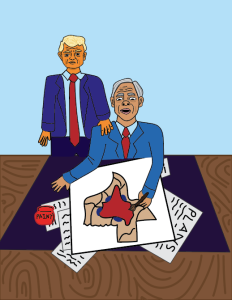In Review: Bridge of Spies
December 3, 2015
A symmetrical shot of one person seen three different ways- Abel painting a self portrait while looking in the mirror. This shot sets the tone for “Bridge of Spies”, directed by Steven Spielberg, a story about a soviet spy, and the man who defended him.
Earning a 92% from rotten tomatoes, and estimated to make $17.5 million in American weekend sales, “Bridge of Spies” is definitely a hit.
Inspired by a true event that took place in 1952, the film follows James Donovan (Tom Hanks), as he sets out to defend Soviet Spy, Rudolf Abel (Mark Rylance), in his trial for treason against the United States. But the tables turn when American Spy, Francis Gary Powers (Austin Stowell) is captured in the Soviet Union, as well as an American college student studying in Berlin.
Donovan is then asked to trade Abel for Powers, but he, even though he wasn’t supposed to, decided to attempt to trade Abel for Powers and the American student. The acting of everyone in “Bridge of Spies” is phenomenal, especially the performance of Mark Rylance (Abel).
He portrayed Abel in such a way that makes the audience very sympathetic of him.
The beginning shot, as mentioned before, foreshadows the many different sides one sees of Abel. Abel as a spy, Abel as an artist, Abel as a husband and father, Abel as a soldier, and Abel as a friend. The audience finds themselves rooting for Abel, and not the American Justice System.
The film tackles many different moral issues as well. Including; does an illegal immigrant gets the same rights as an American? Is one a traitor to one country, if they are loyal to another? Should we treat criminals and traitors differently? All of these are answered in the way Donovan conducts himself while carrying out Abel’s court case and negotiating with the Soviet Union.
Both Donovan’s and Abel’s moral values stand tall and apparent throughout the film. When Donovan and his family is threatened because he is helping a Soviet Spy, he stays firm in his moral beliefs, often saying that “every person matters.” Abel stands out in his calmness and trust. He never panics, never cracks, never relays any information, and when asked if he is worried or frightened he simply replies “would it help?”.
The only problems surrounding “Bridge of Spies” is its length, and a few moments when it gets a bit static. However, these problems are hardly noticeable, considering it is already getting Oscar Buzz; Tom Hanks for Best Actor, and the film for Best Picture. The music for “Bridge of Spies” is also very notable. Composed by Thomas Newman; who is known for his work in Saving Mr. Banks, Cinderella Man, and Finding Nemo.
The music is absent for much of the film, so when it appears it hits the audience, casting the scene in the spotlight, telling them to pay attention- this is important.
The music is very beautiful, sometimes nostalgic, other times military-like, and plays a very crucial role. Another thing that deserves to be noted is the outstanding cinematography. The cinematography plays a huge role in symbolism and plot. The set, the costumes, even what colors were chosen for a specific scene as well as what angle the camera is at- is all present for a specific purpose.
From Soviet war footage being on in the judge’s house, to repeated symmetrical shots of Donovan negotiating- the cinematography is one of the things that make “Bridge of Spies” so interesting to watch. “Bridge of Spies” is a very impressive and a cinematically beautiful film, which takes on hard moral questions, portrayed a complicated true story with accuracy, and is charmingly funny. It is definitely a film to put at the top of your to do list.









